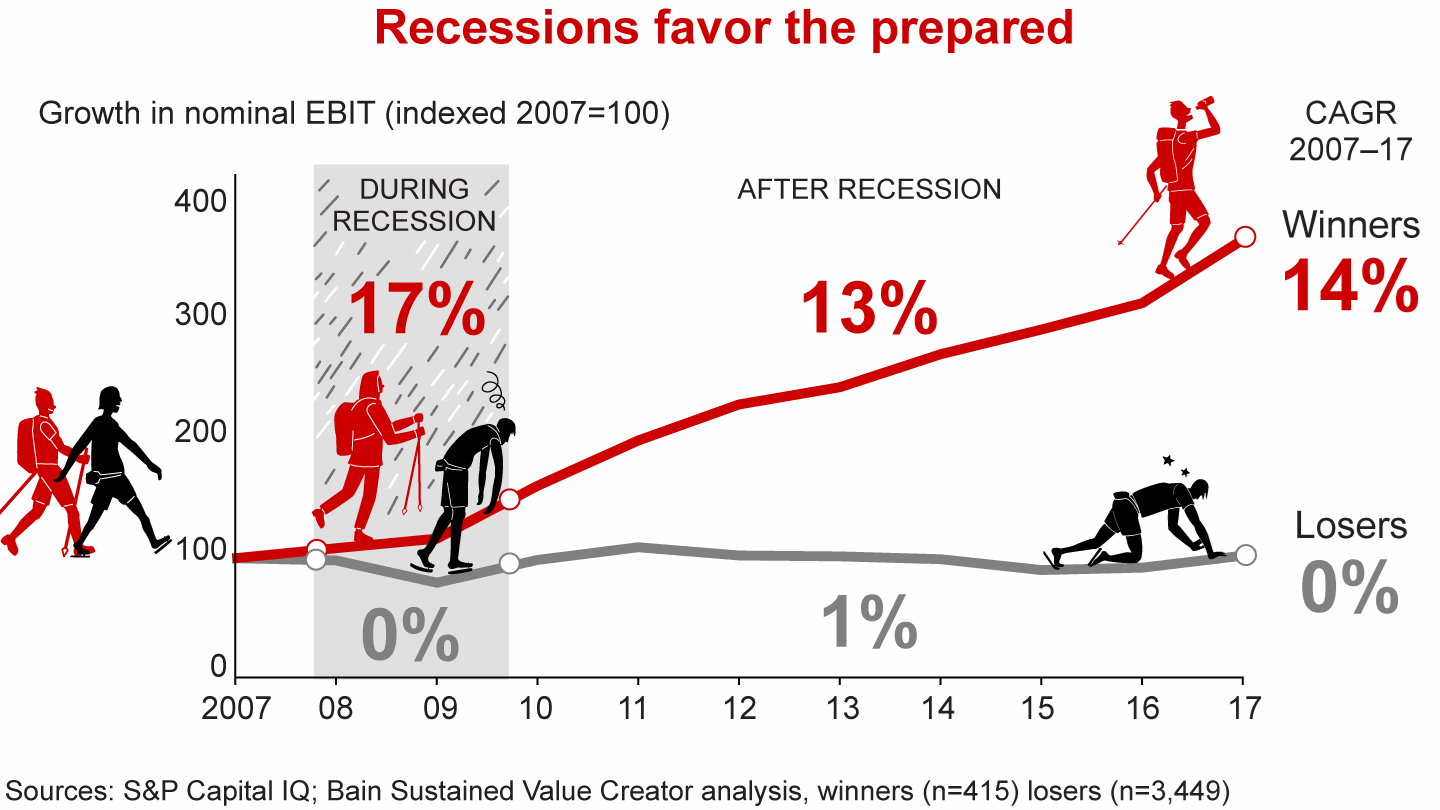Inverted yield curve. Trade wars. GDP. Bubble. As the buzzwords surrounding recession are thrown around in the news and in board rooms across the globe, it has our organization and our clients thinking about how they might start preparing for the next recession. While no one can predict when the next recession will come nor how long it might be, one thing is certain–it will come, and proactive organizations have the best outcomes.
Why prepare now?
We recently saw an article and graphic from Bain that sparked our interest and helps quantify the impact of preparing for a recession before it hits:

In the findings from Bain, it stated that 89% of companies lost profitability during the last downturn. But those 11% who didn’t lose profitability during the last downturn saw 17% higher revenue than during non-economic recession periods. So, those who were well positioned for a recession not only succeeded during a period when their competitors remained flat, but were also positioned to maintain their momentum when the recession was over.
According to Bain, winning organizations excelled in four areas: early cost restructuring, plus some combination of balance sheet discipline, aggressive commercial growth plays and proactive M&A.
So, where do you begin?
Instead of waiting for the recession to come knocking on your door and reacting with panic, what can you do to proactively prepare? You don’t need to start cutting on your balance sheet tomorrow, but having a one-page overview and action plan in place is where we recommend starting.
The first and most important thing we advise our clients to do is to clearly identify the leading indicators that tell your organization you will be heading towards a recession period. The key phrase here is leading indicators. One of the many reasons we build strategic plans based on the balanced scorecard methodology is because it’s a balance of monitoring the health of your business and strategic plan with a good combination of leading and lagging indicators.
So, ask yourself [and your organization] what are the leading indicators we need to monitor that would signal we might be heading into a recession period. What external and internal metrics might we watch that signal it’s time to proactively prepare?
The answer is going to be different for every organization and industry type, but here are a few examples:
- Construction: Number of New Building Permits Issued. This typically forecasts the new construction for 6-9 months.
- Professional Services: Number of scopes of works created. This helps organizations forecast business 3-9 months in advance.
- Real Estate: Amount of inventory available. This helps real estate brokers understand how much inventory is (or is not) available in the market and indicates supply or demand issues.
- Manufacturing: Days of supply in inventory. This helps organizations keep a pulse on their inventory levels against the demand of product from consumers.
- Manufacturing: Availability of supply for raw material. This helps organizations understand if there is a sudden drop in demand for material in like-industry organizations.
I’ve identified my leading indicators. Now what?
With your leading indicators identified, we advise that your organization come up with a set of clearly identified levers to begin pulling once you realize a recession is coming for your organization. Your leading indicators should give you some runway, anywhere from 6 months to 1 year in some cases, to be fully prepared for an economic shift in your business. In many cases, those months gives your organization the runway it needs to shift and adapt to the market.
Again, borrowing from Bain’s article, here are a few recommendations you might consider:
- Cost reduction: What can you do to reduce your costs quickly?
- Working capital: How can you shift your practices to provide more working capital?
- Efficiency: How can we pare down business units to be more efficient?
- Offense: What do we need to invest in to play offense during an economic downturn?

Putting it together
To put it together, we recommend making a 1-page addendum to your strategic plan that clearly outlines what your leading indicators are that signal a coming recession and what strategic levers your organization can pull to be proactive.
There’s no reason to shift from your strategic plan right now just because you thinka recession is coming. Put your warning buoys in the water and be ready to act when those alarms have sounded. Instead of completely shifting your business from something that might come, be prepared to shift your business when you know it’s coming. It’s a balance of taking advantage of this currently booming economy and preparing for one that isn’t.












Appropiated articule for the COVID-19 situation!